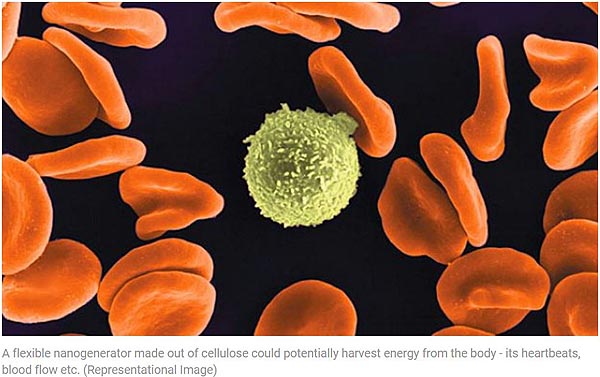Cellulose Nanogenerators May Power Medical Implants
NDTV, New Delhi, India, reports this week that Indian scientists have developed a flexible nanogenerator out of cellulose that could power future implanted biomedical devices by harvesting energy from the human body.
Implantable electronics can deliver drugs, monitor vital signs, and perform other health-related roles. But finding a way to power them remains a challenge.
Now, scientists from the Department of Physics at Jadavpur University in Kolkata have built a flexible nanogenerator out of cellulose, an abundant natural material, that could potentially harvest energy from the body - its heartbeats, blood flow, and other almost imperceptible but constant movements.
Efforts to convert the energy of motion - from footsteps, ocean waves, wind, and other movement sources - are well underway.
"Basically cellulose is natural materials, purified form of wood, where few compounds such as hemicellulose and lignin are removed," Dipankar Mandal, assistant professor of the Department of Physics Organic Nano-Piezoelectric Device Laboratory, told PTI.
"Since our biomedical device (Cellulose nanogenerator) is made with cellulose, this is of major importance/significance to our research work. It is naturally abundant. As a result, the cost of the device will be significantly less, to the point that would be affordable by common people It is expected that this type of wood made biomedical device can be very useful for health-care monitoring that could be operated from home, so the initial health checkup can be very easily and regular manner," he added.
Many of these developing technologies are designed with the goal of powering everyday gadgets and even buildings. As such, they do not need to bend and are often made with stiff materials. However, to power biomedical devices inside of the body, a flexible generator could provide more versatility. So Mandal and his student Mehebub Alam at Jadavpur University set out to design one.
The researchers turned to cellulose, the most abundant biopolymer on Earth, and mixed it in a simple process with a kind of silicone called polydimethylsiloxane - the material used in breast implants - and carbon nanotubes.
Repeated pressing on the resulting nanogenerator lit up about two dozen LEDs instantly. It also charged capacitors that powered a portable Liquid-crystal-display (LCD), a calculator, and a wrist watch.
Since cellulose is non-toxic, the researchers said the device could potentially be implanted in the body and harvest its internal stretches, vibrations, and other movements.
TAPPI
http://www.tappi.org/

